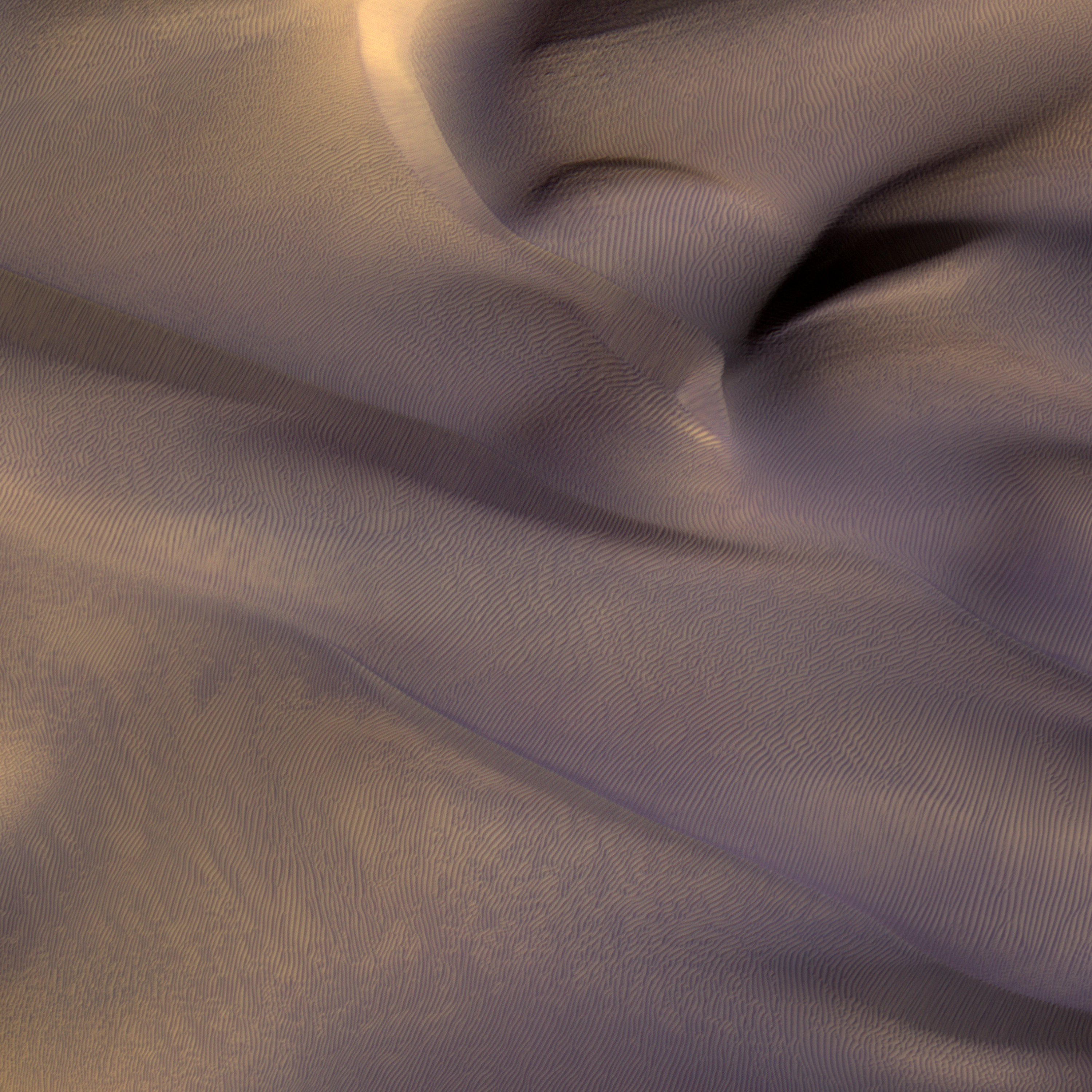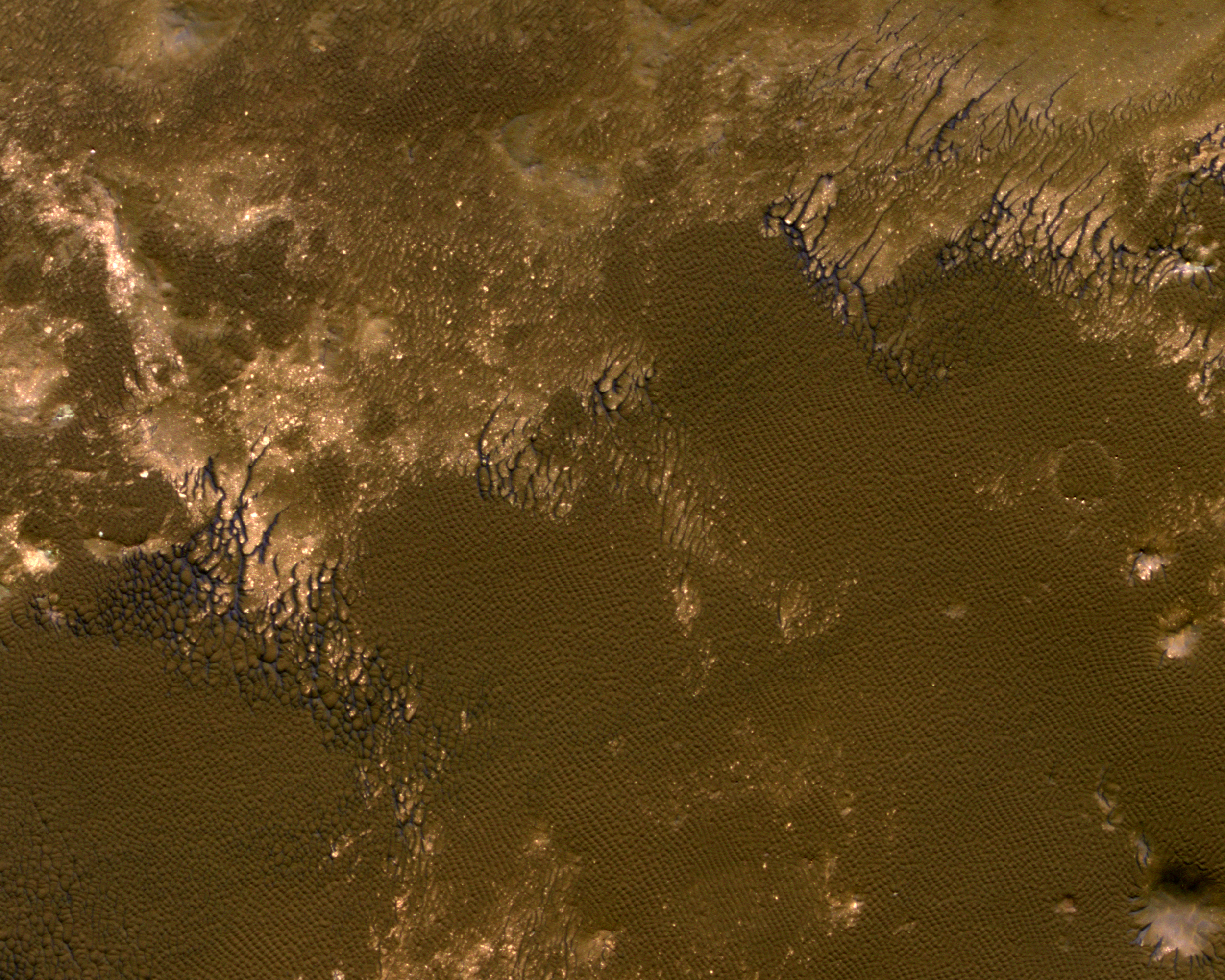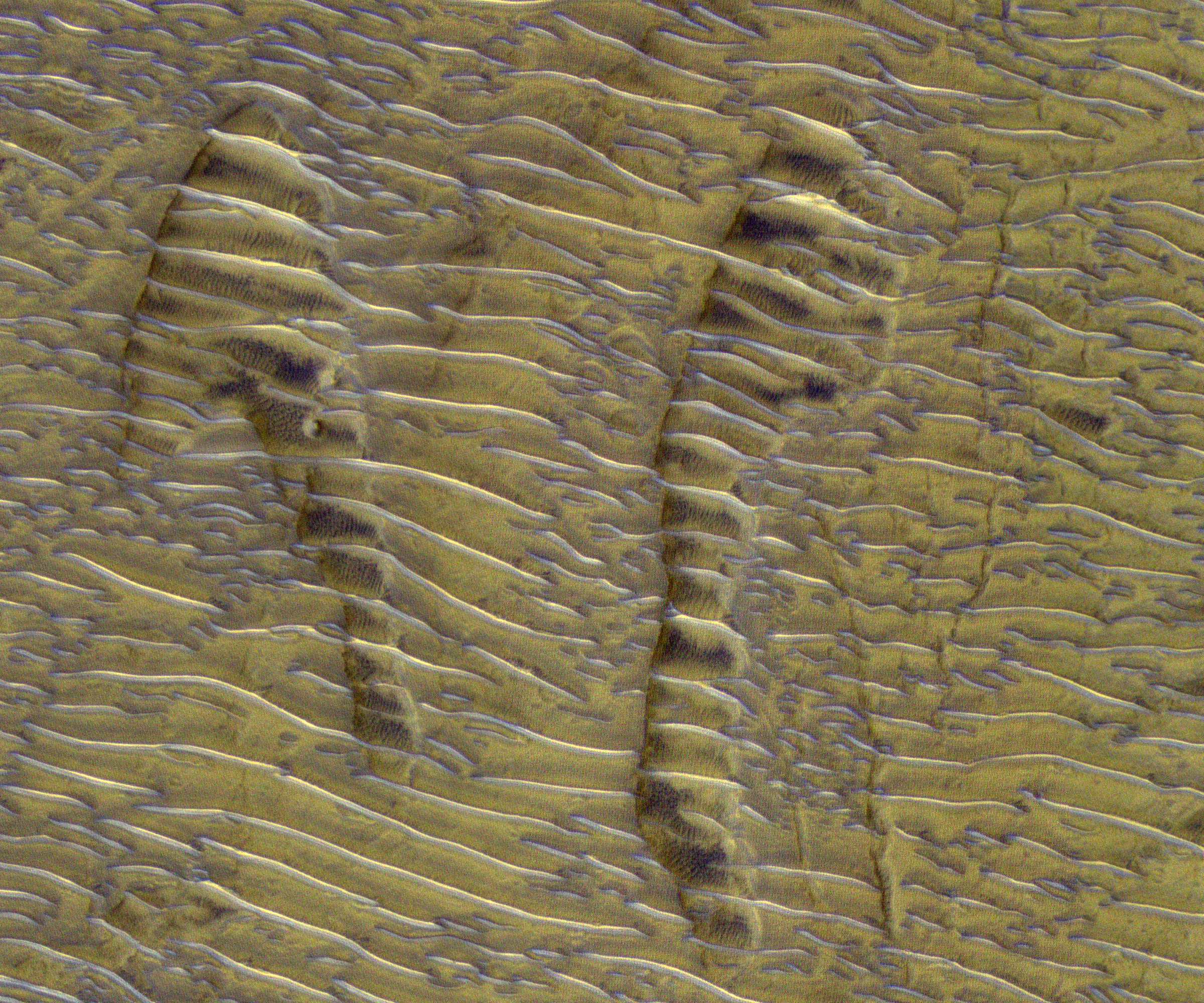HiRISE images
Ever shifting

Dunes are just so amazingly beautiful. I'll never get over how nature can sculpt such regular patterns into endlessly overlapping structures. Here's a small bit of a dune field trapped up high between mountains in the middle of Coprates Chasma. Here I'm not focusing on their setting, but rather the intricate structures of the dunes themselves. The dunes are formed by wind funneling down a narrow valley, headed towards the floor of the much bigger chasma (to the left, far offstage).
Here we are in the midst of a dune field, looking at a rippled sandy surface that piles into dunes.... read more ❯
The end of winter

Richardson crater is located at 72ºS, about 1000 km (~621 miles) from the south pole of Mars. It's a moderately large crater, about 90 km (56) miles across, and it's mostly filled by one of the biggest dune fields in the southern hemisphere.
The dune field has been targeted repeatedly by HiRISE, with a recent count of 83 images. I've probably included images in my blog in the past, but a quick search shows I didn't label them (and I'm far too lazy to go searching). But no matter, since there are plenty of brand new images of the place to... read more ❯
Different sands

There's a lot we don't understand about the sediment on Mars. Water, wind, ice, changing temperatures, and volcanic eruptions can all break rocks into grains small enough for the wind to transport. The smallest grains are lofted by the wind, contributing to dust storms, and settling out as fine layers of dust. Slightly larger grains hop (saltate) along the ground and self-organize into beautiful ripples and dunes. Even larger grains (more than a few millimeters in diameter) might be moved by the wind on occasion - these grains are too big to saltate (unless the wind is really strong), but... read more ❯
Where dunes once trod

Mars has been dusty, and that's affecting the quality of HiRISE images (just look at the recent images in the catalog and you'll see they're not that great). That's made it hard for me to choose a good one for my blog. I suppose I could go with a grainy image and talk about things like the "cost of real data" and "one person's noise is another person's data" (because surely someone will make use of those poor-quality images to track dust clouds, or something). I'm waiting to see where the bright dust falls out on the surface, because I... read more ❯
Oh, Mars!

The HiRISE camera has a website called HiWish that lets anybody (yes, even you!) make image requests. That's right, you can choose any spot on Mars that HiRISE can see, pick any season (or let them pick for you if you don't care), and one day the Mars Reconnaissance Orbiter's path will fly over your spot and, if it isn't scheduled for other observations, HiRISE will take your image!
I've made several requests that way. Sometimes I want to get repeat coverage of an area to see if dunes and ripples have migrated - that requires both a "before" and an... read more ❯
Spring is a messy time

In many areas on Earth that get winter snow, spring thaw is a messy time. Frozen ground turns to mud, and there may be runoff everywhere from melting snow and spring rain. Or if you live in a place that gets winter rains, spring might be the time when mudslides are most common. Spring can be messy on Mars too, although in this case the ice isn't H2O, but CO2. Also, it's not melting, but rather sublimating. But that can still make a big mess.
Here's part of a dune field in early spring, located in the high southern latitudes. Normally... read more ❯
Field of barchans

It's July, and I've had a busy summer so far. This is my first post in a few weeks - I've been out at various meetings, and last week I spent with my family on vacation. The one week of normal work I had was spent furiously working to help a colleague put together a paper. That left me no time to share pretty pictures with the world. So finally I'm back and able to make another blog post. I decided to make it simple: just a field of pretty barchans.
View is 750x500 m (0.47x0.31 mi), HiRISE... read more ❯
The Mars Global Digital Dune Database

There are a lot of dune fields on Mars. Over the last ten years I've been part of a group that's mapped out the big dark dunes on the planet to see where they form, and to understand the sedimentary and meteorological processes that control their formation. We compiled a database showing their locations and various physical characteristics.
Wait, why do piles of sand form in the first place? On Earth, it's because:
1. There's a lot of sand (not a surprise).
2. There's a lot of strong wind (also not a surprise).
3. The sand is free to be moved by the wind.... read more ❯
Entourage

Here's a grand dune, making its stately way northward under winds blowing mainly from the south-southeast (bottom to top), with a secondary wind blowing from the southwest (lower left to upper right). There are two rippled and sharp-crested slip faces on this dune -- can you identify both of them (hint: each wind creates one slip face on the downwind side)?
The dune is ~750 m (2,460 ft) long. It's made of dark sand the wind blows along the ground until it piles up into these big... read more ❯
Wild & dark lacy dunes on twisty bright layers

Some windblown dunes on Mars are just beyond words. Take these beasts in this 0.95x0.95 km (0.59x0.59 mi) scene:
These are a peculiar type of bedform called a transverse aeolian ridge, or TAR for short, with a spacing of about 50 m (164 ft). Nobody really understands these things: are they dunes or ripples or something totally different? They're common on Mars but unusual (maybe even nonexistent) on Earth. They're also pretty dark-toned here, whereas on most of Mars they tend to be lighter than the surrounding rocks.
The TARs mostly cover the surface,... read more ❯